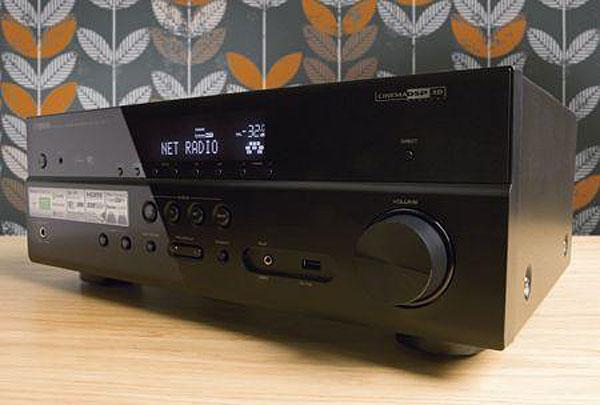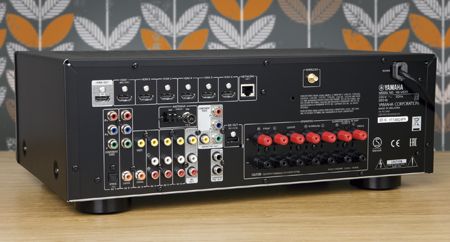Yamaha RX-V577 AV receiver review

 The £500 AVR market is more competitive than the final stages of The Great British Bake-Off. These days, it’s no good simply offering multichannel decoding and amplification with the odd DSP mode and a raft of HDMI sockets. No: you have to spread the love and get your AVR to cosy up to all the other technological toys that are stuffed with entertainment content, including smartphones and servers. And the best way to do that is sans wires.
The £500 AVR market is more competitive than the final stages of The Great British Bake-Off. These days, it’s no good simply offering multichannel decoding and amplification with the odd DSP mode and a raft of HDMI sockets. No: you have to spread the love and get your AVR to cosy up to all the other technological toys that are stuffed with entertainment content, including smartphones and servers. And the best way to do that is sans wires.
Yamaha has more than made up for being a tad late to the Wi-Fi party by allowing its new RX-V577 to get its wireless tentacles into a number of connected services, including vTuner internet radio, DLNA streaming, AirPlay, HTC Connect and Spotify Connect. Yet proving that you can never have your cake and scoff it, absent from the mix is Bluetooth, although you can plumb in an optional Bluetooth receiver, at a cost of £50.
Another major AVR asset these days is an app for controlling your kit using a phone or tablet. Yamaha’s AV Controller has been rather good for a few years, keeping the pace with the likes of Pioneer in terms of slickness and usability, and is a big part of the RX-V577 story. Other important chapters in the tale include: HDMI 2.0 connectivity with support for 4K/Ultra HD 50Hz/60Hz signal passthrough; support for wireless/USB streaming of FLAC, WAV and ALAC formats up to 24-bit/192kHz with gapless playback; and assignable amplifiers for bi-amping or Zone B use.
And, of course, being a Yamaha, there is no shortage of DSP modes to recreate the experience of listening to the New Year’s Day concert in Vienna or simply for optimising the listening experience according to the genre of movie or TV show being watched. All in all, a healthy roster of features that makes the RX-V577 a compelling proposition in the down-and-dirty £500 arena.
Design-wise, the RX-V577 is nothing to write home about. It’s inoffensive enough from across a room and has a nice legible dot matrix display, but its random scattering of sockets and buttons leaves a bit to be desired. Nor do you get the feeling that its the most solid of home theatre components around, but that's expected in this market.
At least the layout of sockets around the back is decent, with everything logically grouped. Build quality of speaker terminals and the casing is reasonable, considering the price, but removing the caps from the terminals to fit banana plugs requires considerable strength and care not to damage the plastic. Gratifyingly, there are two subwoofer line-outs, whilst the amp also boasts a bass boost feature for setups using small speakers. Clearly, the RX-V577 is intended for use in small-to- medium-sized living rooms or home cinemas (although the YPAO Reflected Sound Control setup process is apparently able to detect speakers up to 24m away from the mic).
Smooth operatorLack of Bluetooth aside, Yamaha's wireless implementation is highly impressive, and includes Wireless Direct, which allows you to stream music directly from a phone or tablet in the absence of a wireless router, as well as allowing full control of the amp using the app. Particularly good with the latter is the 3D room layout graphic that lets you pinch to resize the sound space, and the EQ graphs that let you tweak parameters such as reverb, delay and 'liveliness'. The app also recreates all of the features of the bundled handset and its display is infinitely preferable to the AVR’s own onscreen GUI, which wouldn’t look out of place on a Sinclair ZX Spectrum. Using the app also avoids having the menu appear over whatever you’re watching. So, basically... use the app.
WPS pairing avoids the hassle of inputting passwords; HTC Connect serves users of HTC phones and AirPlay does likewise for iOS devices. You'll need a premium Spotify account to take advantage of Spotify Connect.
DLNA execution is top-notch with full folder structure visible in connected drives and seamless, gapless playback of standard-res and hi-res tunes. Other niceties include the Scene button on the remote, which quickly powers up the HDMI CEC-connected components required, say, for watching a movie (TV and BD deck). Worth setting up.

As for its core home cinema duties, the RX-V577 is a versatile beast, claiming to even be able to produce virtual seven-channel surround sound from just two or three front speakers (a big idea in Europe, we're told). Cinema DSP 3D provides a wide, high and dense soundfield from audio sources with a virtual presence speaker producing what is oddly called 3-dimensional sound. There’s nothing virtual about the YPAO installation, a rapid-fire method of setting the speakers using acoustic reflections. It is not foolproof, though, it got all the distances correct for my rig but made errors with the speaker sizes.
Performance-wise, the amp’s streaming audio ability is nowt short of superb. It’s a doddle to find and select hi-res audio from a NAS drive, and 96kHz/24-bit ALAC and 192kHz/24-bit FLACs played with consummate refinement through a set of Q Acoustics Q7000 speakers. The bass in Bob Marley’s Could You Be Loved is tighter than Scrooge’s purse strings, whilst Susan Wong’s vocals in Desperado, like the piano’s higher octaves, are exquisitely delivered with precision and energy. The Yamaha's sound is terrifically clean; like its Pioneer VSX-924 rival, some may consider it a tad too clinical, lacking a bit of warmth.
The same qualities apply to the RX-V577’s multichannel movie delivery. Happy days are here again with Ron Howard’s F1-biopic Rush, revealing every last detail in the DTS-HD MA soundtrack pumped through a regular 5.1 system. At the start of the Japanese Grand Prix, carefully-placed noises such as cars revving off to one side, rumbling thunder in the distance, heavy rain bucketing down and rain drops plopping delicately onto the tarmac all have a delicate yet defined effect. Like its 2013 predecessor, this is an AVR that loves finding the details in a soundmix. It's equally adept with high-intensity action, such as fast accelerating cars passing in an acoustic arc to match their movement across the screen. Screeching, blistering tyres and close ups of pistons going like the clappers are all powerful yet intelligible. A £500 thriller? Indeed.
The amp has more DSP modes than James Hunt had dolly birds, and I'll admit that while many will steer clear, these have their uses with broadcast material. For example, I found football benefitted from the Sports mode by emphasising commentary in the centre channel.
Overall then, the RX-V577 is worth considering purely based on its home cinema sonics. The fact that it's enjoyable to operate (especially via the app) and makes a decent audio streamer is the icing on the cake. However, the absence of Bluetooth is, as Mary Berry would say, the soggy bottom.
Specification
Dolby True HD: Yes. Plus Pro-Logic IIx; Dolby Digital EX; Dolby Digital Plus
Dolby Atmos: No
DTS-HD Master Audio: Yes. Plus DTS ES Matrix 6.1; DTS Discrete 6.1; DTS Neo:6; DTS 96/24
THX: No
Multichannel input: No
Multichannel output (claimed): 7 x 115W (1kHz, 0.9% THD, 8 ohms, one channel)
Multiroom: Yes. Zone 2
AV inputs: Yes. 4 x composite; 3 x digital audio (1 x optical and 2 x coaxial)
HDMI: Yes. 6 x inputs; 1 x output (HDMI 2.0)
Video upscaling: Yes. To 4K
Component video: Yes. 2 x inputs; 1 x output
Dimensions: 435(w) x 161(d) x 315(h)mm
Weight: 8.1kg
Also featuring: iOS/Android control apps; vTuner internet radio; Wi-Fi; Wireless Direct; AirPlay; HTC Connect; Spotify Connect; DLNA compatible; Ethernet; USB; binding-post speaker terminals; 2 x subwoofer line outs; bi-amplification; lip sync; Scene feature; Cinema DSP; Virtual Presence Speaker; Compressed Music Enhancer; numerous DSP modes (7ch stereo, Vienna Hall, Cellar Club, Roxy Theatre, Sci-Fi, Adventure, etc); media playback including hi-res FLAC, WAV, and ALAC files; FM/AM tuner with RDS; 3 x analogue stereo phono inputs; composite video out; 12V trigger; headphones jack; YPAO room EQ
 |
Home Cinema Choice #351 is on sale now, featuring: Samsung S95D flagship OLED TV; Ascendo loudspeakers; Pioneer VSA-LX805 AV receiver; UST projector roundup; 2024’s summer movies; Conan 4K; and more
|






















































